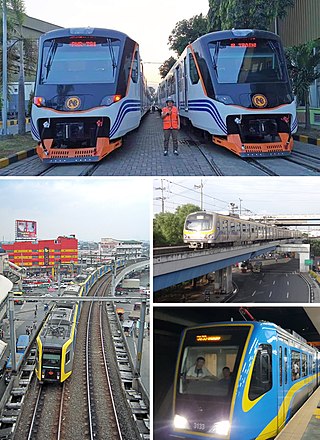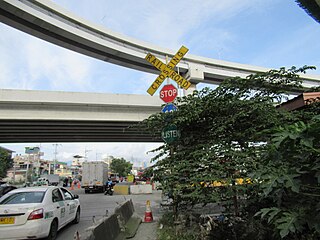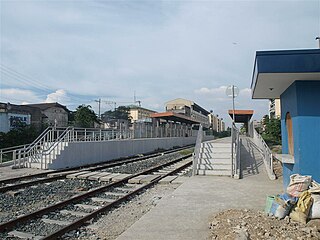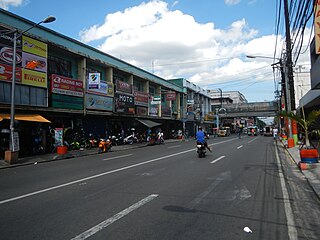
The Philippine National Railways (PNR) is a state-owned railway company in the Philippines which operates one commuter rail service between Laguna and Quezon, and local services between Sipocot, Naga and Legazpi in the Bicol Region. It is an attached agency of the Department of Transportation.

Rail transportation in the Philippines is currently used mostly to transport passengers within Metro Manila and provinces of Laguna and Quezon, as well as a commuter service in the Bicol Region. Freight transport services once operated in the country, but these services were halted. However, there are plans to restore old freight services and build new lines. From a peak of 1,100 kilometers (680 mi), the country currently has a railway footprint of 533.14 kilometers (331.28 mi), of which only 129.85 kilometers (80.69 mi) are operational as of 2024, including all the urban rail lines. World War II, natural calamities, underspending, and neglect have all contributed to the decline of the Philippine railway network. In the 2019 Global Competitiveness Report, the Philippines has the lowest efficiency score among other Asian countries in terms of efficiency of train services, receiving a score of 2.4, and ranking 86th out of 101 countries globally. The government is currently expanding the railway network up to 1,900 kilometers (1,200 mi) by 2022 through numerous projects.

The Metro Manila Skyway, officially the Metro Manila Skyway System (MMSS) or simply the Skyway, is an elevated highway serving as the main expressway of Metro Manila, Philippines. It connects the North and South Luzon Expressways with access to Ninoy Aquino International Airport via the NAIA Expressway (NAIAX). It is the first fully grade-separated highway in the Philippines and one of the longest elevated highways in the world, with a total length of approximately 39.2 kilometers (24.4 mi).

5th Avenue station is a railway station located on the North Main Line in Caloocan, Metro Manila, Philippines. Facilities such as ramps and platforms were planned to be constructed near the level crossing with C-3 Road. The plans to rehabilitate this part of PNR's network were implemented but no concrete platforms were erected.

EDSA station is a railway station located on the South Main Line in Makati, Metro Manila, Philippines. It derives its name from nearby Epifanio de los Santos Avenue. It is currently being repurposed to become a station of the under construction North–South Commuter Railway.

FTI station is a railway station located on the South Main Line in Taguig, Metro Manila, Philippines. It is named after its major landmark, the grounds of the formerly state-owned Food Terminal, Inc. which is now renamed as Arca South.

Solis station is a railway station located on the North Main Line in the city of Manila, Philippines.

Valenzuela station, also known as West Valenzuela station, is an under-construction elevated North–South Commuter Railway (NSCR) station located in Valenzuela, Metro Manila, Philippines. The station was part of the Philippine National Railways (PNR) North Main Line before its closure in the 1980s.

Caloocan station is a railway station located on the North Main Line in Caloocan, Metro Manila, Philippines. It is rebuilt from its original location, now situated adjacent to the Caloocan railway depot, near Samson Road.

Balagtas station is an under-construction elevated North–South Commuter Railway (NSCR) station located in Balagtas, Bulacan, Philippines. The station was part of the Philippine National Railways (PNR) North Main Line before its closure in the 1980s. It was also the terminus of the defunct Balagtas–Cabanatuan line.

The PNR Metro Commuter Line was a commuter rail line operated by the Philippine National Railways. It was first inaugurated as the Metro Manila Commuter Service in 1970, and originally served the North Main Line and the South Main Lines, as well as the defunct Carmona and Guadalupe branch lines. Since then, it adopted several names such as Metrotrak and Metrotren, before adopting its present name in the late 2000s. The line was also nicknamed the Orange Line due to its designation in the 1970s.

Malolos station is an under-construction elevated North–South Commuter Railway (NSCR) station located in Malolos, Bulacan, Philippines.

Dela Rosa station is a railway station located on the South Main Line in Makati, Metro Manila, Philippines.

NLEX Harbor Link, signed as E5 of the Philippine expressway network, is a four- to six-lane expressway that serves as a spur of North Luzon Expressway (NLEX) linking it to the Port of Manila to the west and Quezon City to the east. It runs from Katipunan and C.P. Garcia Avenues in Quezon City to Radial Road 10 in Navotas, which in turn leads to the Port of Manila. Currently, its segment from Mindanao Avenue in Valenzuela to Navotas is operational.

Governor Pascual station is the current railway terminus of the North Main Line located in Malabon, Metro Manila, Philippines.

The North–South Commuter Railway, also known as the Clark–Calamba Railway, is a 147-kilometer (91-mile) commuter rail system under construction on the island of Luzon in the Philippines. Running from New Clark City in Capas, Tarlac, to Calamba, Laguna, with 36 stations and four services, the railway is designed to improve connectivity within the Greater Manila Area and will be integrated with the railway network in the region.

10th Avenue, formerly known as Macario Asistio Sr. Avenue or simply Asistio Avenue, is an undivided four-lane street in Caloocan, Metro Manila, Philippines that stretches east–west, bisecting south Caloocan. Like most avenues in the Grace Park area, it crosses a grid system of numbered streets that run from north to south, with other numbered avenues running from east to west. 10th Avenue was formally renamed as "Asistio Avenue" prior to the reversion of its current name, owing to it being the tenth avenue running east–west from the city's border with Manila in the south. The former renaming was done in 1984 to honor the former mayor of Caloocan who served from 1962 to 1971 and the father of another Caloocan mayor Boy Asistio, but has since been disregarded and reverted.

The PNR North Main Line is one of the two trunk lines of the Philippine National Railways in the island of Luzon, the other being the PNR South Main Line. The line during its maximum extent led to various cities and municipalities in Central Luzon and the Ilocos Region.

NLEX Connector, also known as the NLEX–SLEX Connector Road, NLEX Connector Road, and NLEX Segment 11 during the planning stages, is a 7.7-kilometer (4.8 mi), four-lane elevated expressway in Metro Manila, Philippines. It connects the NLEX Harbor Link to the Metro Manila Skyway, which in turn connect to the North and South Luzon Expressways, respectively, while traversing parallel to the PNR Metro Commuter Line. The highway has five interchanges, four of which is currently operational. Alongside NLEX Harbor Link, trucks are allowed to use it.






















